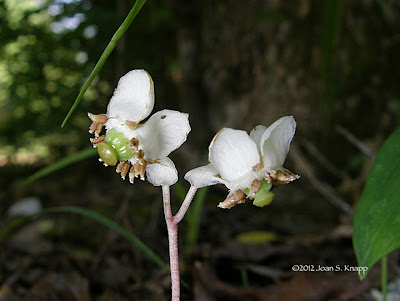May 12th. Scutellaria elliptica
We found the first species on the west side of Starr Road in Jones County. The plants stood less that 12 inches high.
 The plant
The plant Its leaves, opposite and with obviously crenate margins.
Its leaves, opposite and with obviously crenate margins. The flower head
The flower head A closer view of the flower head
A closer view of the flower head Close ups of individual flowers
Close ups of individual flowersMay 12th. Scutellaria integrifolia
We found these plants at the north end of Pond 2A in the Piedmont NWR. The plants stood about 12-15 inches tall.
 The top of the flower head
The top of the flower head The stem showing long leaves with smooth edges
The stem showing long leaves with smooth edges Close up views of an individual flower
Close up views of an individual flowerJune 23rd, 2012.
We found these plants on the west facing slope of the dam at Pond 2A. They were hidden in the grass, barely 6-8 inches tall. I’m not sure which species this is but think it might also be Scutellaria elliptica. I'd appreciate any corrections of this identification.
 Flowers near the top of the plant
Flowers near the top of the plant A close up views of individual flowers
A close up views of individual flowersScutellaria elliptica (Hairy Skullcap) is native to the United States where it grows in most states in the eastern United States. In Georgia, it has been documented mainly in counties in the Piedmont and in some southwestern counties. It blooms from May to July. Based on the photographs referenced below, the markings on the flowers vary quite widely.
Scutellaria integrifolia (Helmet Flower, Helmen Skullcap, Hyssop Skullcap) is native to the United States where it grows in states from Connecticut-New York to Oklahoma-Texas. In Georgia, it has been documented in counties throughout the state. It blooms from May to August.
Click on an image to view a larger image
Identification resources:
Scutellaria elliptica (Hairy skullcap)
Southeastern Flora
Name that Plant: Native and Naturalized Plants of the Carolinas and Georgia
Missouri Plants
Alabama Plants
Alan Cressler
- Madison County, Alabama
- Cahaba NWR, Bibb County, Alabama
- Union County, Georg
- Chattahoochee National Forest, Gilmer County, Georgia
- Chattahoochee National Forest, Union County, Georgia
Scutellaria integrifolia (Helmet Flower)
Southeastern Flora
Name that Plant: Native and Naturalized Plants of the Carolinas and Georgia
Alabama Plants
Distribution:
Scutellaria elliptica
United States Department of Agriculture Plants Database
University of North Carolina Herbarium
Scutellaria integrifolia















































